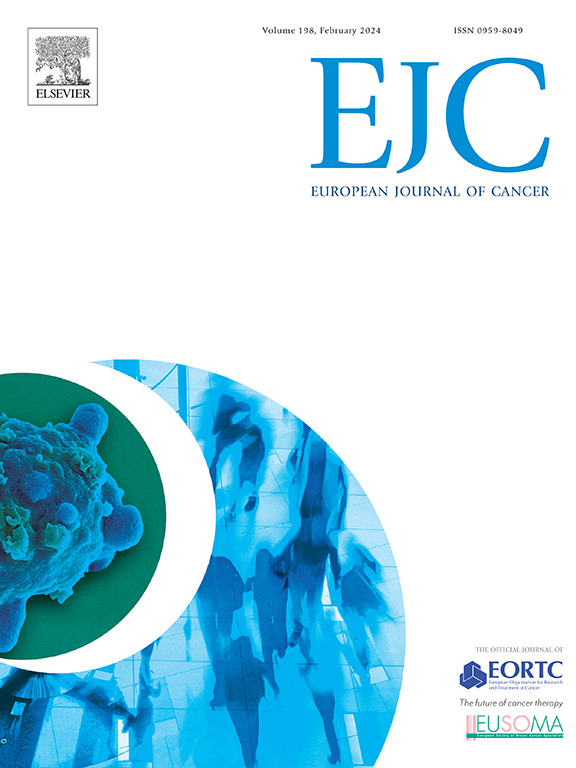在接受维多汀治疗的患者中,药物相关皮肤不良事件与生存结局之间的关系
IF 7.6
1区 医学
Q1 ONCOLOGY
引用次数: 0
摘要
研究目的:抗体-药物偶联药物enfortumab vedotin (EV)被批准用于转移性尿路上皮癌(mUC)患者。ev相关的皮肤毒性经常被报道,ev相关的ae是否与生存相关尚不清楚。我们的目的是报告皮肤毒性与接受EV患者生存之间的关系。方法本回顾性研究纳入了来自两个肿瘤中心的接受单药治疗的EV患者,随访至少3个月,并收集了人口统计学、治疗、毒性和结局的数据。主要终点是有无皮肤毒性患者的无进展生存期(PFS)。总生存期(OS)是次要终点。结果收集2019年7月19日至2024年3月12日63例EV患者的数据。其中,在EV治疗期间出现任何级别皮肤毒性的18例(28.6 %)患者的中位PFS显著延长(mPFS: 9.2个月vs 4.7个月,风险比[HR] 0.35;p = 0.0041)和OS (mOS:未达到vs. 8.4个月,HR 0.38; = 0.0253页)。多因素分析显示,皮肤毒性与改善的PFS有显著相关性(HR 0.40, p = 0.0319),即使保持趋势,与OS无显著相关性(HR 0.41, p = 0.067)。结论这些结果支持任何级别皮肤毒性(皮疹)患者的PFS均延长。随着最近EV +派姆单抗在一线mUC患者中的联合治疗的扩大,需要仔细监测皮肤毒性并提供优化的专门管理,考虑到皮肤毒性可以预测患者的预后。本文章由计算机程序翻译,如有差异,请以英文原文为准。
Association between drug-related cutaneous adverse events and survival outcomes in patients treated with enfortumab vedotin
Aim of the study
The antibody-drug conjugate enfortumab vedotin (EV) received approval in patients with metastatic urothelial carcinoma (mUC). EV-related cutaneous toxicities are frequently reported, whether EV-related AEs association with survival may exist is still unknown. We aim to report the association between cutaneous toxicities and survival in patients receiving EV.
Methods
This retrospective study enrolled patients treated with monotherapy EV from two oncology centers, followed up for at least 3-months, and data collection demographics, treatments, toxicities, and outcomes. The primary endpoint was progression-free survival (PFS) in patients experiencing cutaneous toxicities or not. Overall survival (OS) was the secondary endpoint.
Results
Data from 63 patients treated with EV from July 19, 2019, to March 12, 2024, were collected. Among them, the 18 (28.6 %) patients experiencing any-grade cutaneous toxicities during EV treatment showed significantly longer median PFS (mPFS: 9.2 vs. 4.7 months, hazard ratio [HR] 0.35; p = 0.0041) and OS (mOS: not reached vs. 8.4 months, HR 0.38; p = 0.0253). The multivariate analysis showed a significant association of cutaneous toxicities with improved PFS (HR 0.40, p = 0.0319), and did not demonstrate significant association with OS even if tendency was kept (HR 0.41, p = 0.067).
Conclusion
These results support that patients experiencing any-grade cutaneous toxicity (skin rash) had a prolonged PFS. With the recent expansion of combined treatment using EV plus pembrolizumab in first-line in mUC patients, cutaneous toxicities need to be carefully monitored and optimized dedicated management provided, considering that cutaneous toxicity may be predictive of patient outcome.
求助全文
通过发布文献求助,成功后即可免费获取论文全文。
去求助
来源期刊

European Journal of Cancer
医学-肿瘤学
CiteScore
11.50
自引率
4.80%
发文量
953
审稿时长
23 days
期刊介绍:
The European Journal of Cancer (EJC) serves as a comprehensive platform integrating preclinical, digital, translational, and clinical research across the spectrum of cancer. From epidemiology, carcinogenesis, and biology to groundbreaking innovations in cancer treatment and patient care, the journal covers a wide array of topics. We publish original research, reviews, previews, editorial comments, and correspondence, fostering dialogue and advancement in the fight against cancer. Join us in our mission to drive progress and improve outcomes in cancer research and patient care.
 求助内容:
求助内容: 应助结果提醒方式:
应助结果提醒方式:


